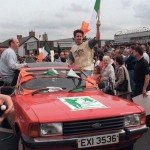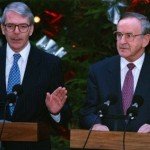
On August 31st 1994 the Provisional Irish Republican Army stunned the world by announcing a conditional ceasefire. After a 25-year campaign of violence and terror, Provisional IRA leaders promised to set down their arms and seek peace through political negotiation. In a five paragraph communique, the Republican group announced a “complete cessation of military operations” in order to “enhance the democratic process”. News of the ceasefire triggered celebrations in Catholic areas of Northern Ireland, though Loyalists remained sceptical. “The struggle is not over”, Sinn Fein leader Gerry Adams told the media, “the struggle has entered a new phase”. Six weeks later Loyalist paramilitary groups followed suit and announced their own ceasefire. The 1994 ceasefire did not last indefinitely: it was shattered in 1996 by devastating bombings in London and Manchester. Nevertheless the Provisional IRA, once committed to absolute victory, now seemed willing to consider a negotiated peace.
The Armalite and the ballot box
The path to an IRA ceasefire was an unsteady one. The movement for a negotiated peace had grown steadily through the 1980s and early 1990s. Many in Northern Ireland had grown tired of the violence, disruption and fear experienced by civilians and children on an almost daily basis. Changes were also afoot within the Provisional IRA. The ‘Provos’ evolved during the 1980s, opting for political strategy as well as paramilitary action. Hunger striker Bobby Sands‘ election to the British House of Commons in April 1981 was a propaganda victory for the Provisional IRA. In the months that followed its leaders embraced a combined political-paramilitary strategy, dubbed ‘the Armalite and the ballot box’. It was a difficult path, given that the non-violent Social Democratic and Labour Party (SDLP) had come to dominate Nationalist politics. In November 1983 Gerry Adams was elected president of Sinn Fein. In 1986 Sinn Fein’s party conference voted to end total abstentionism by taking up its seats in the Oireachtas (Irish parliament). This decision triggered a walkout and the formation of a splinter party called Republican Sinn Fein.

Some new faces on the international scene played a significant role. In November 1990 Margaret Thatcher resigned as British prime minister, elbowed out by members of her own party; Thatcher was replaced by the more moderate John Major. In the Republic of Ireland, controversial taoiseach Charles Haughey was replaced by Albert Reynolds in February 1992. And in November that year Bill Clinton was elected president of the United States. Major and Reynolds were already acquainted through their previous portfolios in finance and their work in the European Union. As national leaders they discussed how to lay the groundwork for a successful peace agreement to end the Troubles. Another significant figure was SDLP leader John Hume. In 1988 Hume held secret meetings with Gerry Adams, stressing to Adams the need for peaceful negotiations and a degree of compromise.
The Downing Street Agreement
In the spring of 1993 Hume and Adams renewed their talks, this time in the public eye. In April they issued a joint statement affirming their desire for a “peaceful and democratic accord for all on this island”. Major and Reynolds also resumed their discussions. These talks culminated in the unveiling of the Downing Street Agreement, shortly before Christmas 1993. The Downing Street Agreement affirmed several important principles. It agreed that peace in Northern Ireland was the responsibility of Belfast, London and Dublin alike (partnership); it insisted that the future status of Northern Ireland could only be changed by a majority of its people (self-determination); it also required that participants in peace talks must reject violence and lay down their arms (ceasefire):
“The British and Irish governments reiterate that the achievement of peace must involve a permanent end to the use of, or support for, paramilitary violence. They confirm that, in these circumstances, democratically mandated parties which establish a commitment to exclusively peaceful methods, and which have shown that they abide by the democratic process, are free to participate fully in democratic politics and to join in dialogue in due course between the governments and the political parties on the way ahead.”
The Downing Street Agreement challenged the power of Northern Ireland’s paramilitary groups. Maintaining their armed campaign would exclude groups like the IRA from the peace process and cast them as warmongers. Responses to the Downing Street Agreement were mixed. A Guardian newspaper poll in late 1993 suggested that 56 per cent of people in Northern Ireland, mostly Catholics and Nationalists, supported the agreement. Protestants and Unionists were more divided. The moderate Ulster Unionist Party (UUP) criticised elements of the agreement but nevertheless accepted its provisions. In contrast, the conservative Democratic Unionist Party (DUP) rejected the agreement entirely. DUP figurehead Ian Paisley called the Downing Street Agreement a “dark hour of treachery” and told Major he had “sold Ulster to buy off the fiendish Republican scum”. Major’s government tried to ease Unionist concerns, assuring them that the IRA would not participate until it had decommissioned its weapons. These assurances fell mostly on deaf ears.
The violence continues into 1994

The Provisional IRA also had its doubts about the Downing Street Agreement, which met no Republican demands. The Provisionals refused to disarm and continued their military campaign, albeit with caution and selectivity. In March 1994 Provisional IRA volunteers attacked runways at Heathrow Airport, launching a dozen improvised mortars, all of which failed to detonate. In June the Irish National Liberation Army (INLA) murdered three members of the Ulster Volunteer Force (UVF) in Belfast. The UVF retaliated by killing a Catholic taxi driver, then gunning down six people watching a World Cup game in a Loughinisland pub. Tit-for-tat killings continued through July. Yet despite these incidents, many Republicans believed more could be gained at the negotiating table than with sporadic acts of violence.

On August 31st 1994, as Provisional IRA leaders were drafting the ceasefire declaration, UVF members shot dead Sean McDermott, a 37-year-old Catholic civilian from Antrim. Even this did not halt the ceasefire, which was announced hours after McDermott’s murder and came into effect at midnight that night. Political leaders welcomed the IRA’s willingness to prioritise negotiation over killing, though they were guarded in their optimism. “We are beyond the beginning”, said John Major, “but we are not yet in sight of the end”. The typically bellicose Paisley called the IRA ceasefire “an insult to they people they slaughtered because there was no expression of regret”. Politicians called on Loyalist paramilitary groups to follow suit and announce their own ceasefire. They did so in a promisingly optimistic declaration made six weeks later.
The ceasefire collapses
“Decomissioning was the term used in Northern Ireland to refer to paramilitary groups putting their weapons beyond use. This issue became the bête noire [unpopular issue] of the peace process, particularly as Unionists refused to negotiate with, and later sit in government with Sinn Fein until the IRA had put its weapons beyond use… Once the IRA ceasefire was declared in 1994 it quickly became the key obstacle to process. Failure to resolve it left the Northern Ireland peace process vulnerable.”
Dawn Walsh, historian
The 1994 ceasefire held for almost 18 months. There were only nine victims of politically motivated killings during this period, most of them Catholics killed for drug dealing or in internecine feuding. In March 1995 the situation in Northern Ireland had eased enough for a visit from Queen Elizabeth II. In May, Gerry Adams was granted a visa to travel to the United States, evidence that he was now taken seriously as a politician. Sectarian tensions emerged again during the 1995 marching season, fuelled by the Orange Order’s march through Portadown to Drumcree. The traditional route took marchers along Garvaghy Road, a predominately Catholic area. Disorder and rioting erupted when police, seeking to prevent a confrontation, prevented the Orange Order from taking this route. A compromise was reached and the marchers were allowed to proceed, albeit without music or noise. The situation recurred in 1996 with even more violence and the murder of a Catholic taxi driver.
The Provisional IRA broke its ceasefire in February 1996. This was a response to rising sectarianism and Sinn Fein being excluded from peace negotiations until the IRA had disarmed. On February 9th the Provisionals detonated a massive truck bomb in the London Docklands. A warning had been phoned in 90 minutes earlier but two people still lingering in the area were killed. The damage to buildings and infrastructure was enormous, estimated at more than £140 million. On June 15th an even larger truck bomb was detonated in Corporation Street, central Manchester. The damage from this blast was estimated at up to £700 million. The Provisionals also returned to attacking British soldiers and Royal Ulster Constabulary (RUC) officers in Northern Ireland. Loyalist paramilitaries responded in kind. A total of 36 people were killed in Troubles-related violence between February 1996 and July 19th 1997, when the Provisional IRA declared its second ceasefire.

1. The Provisional IRA underwent a transformation in the 1980s, adopting the ‘Armalite and the ballot box’ strategy that combined paramilitary action with political participation.
2. The groundwork for the IRA’s 1994 ceasefire was laid by a series of talks between Gerry Adams, John Hume, new British prime minister John Major and Irish leader Albert Reynolds.
3. In December 1993 Major and Reynolds unveiled the Downing Street Agreement, outlining a set of principles including partnership, self-determination and a paramilitary ceasefire.
4. With Sinn Fein now willing to negotiate, the Provisional IRA announced a conditional ceasefire in August 1994. Loyalist paramilitary groups followed suit six weeks later.
5. The Provisionals withdrew the ceasefire in early 1996 after Sinn Fein’s exclusion from talks. They launched a series of deadly bomb attacks before restoring the ceasefire in July 1997.

The IRA’s TUAS memo on nationalist strategy during the peace process (1994)
The Provisional IRA declares an indefinite ceasefire (August 1994)
Loyalist paramilitary groups declare a ceasefire (October 1994)
© Alpha History 2017. Content on this page may not be republished or distributed without permission. For more information please refer to our Terms of Use.
This page was written by Rebekah Poole and Steve Thompson. To reference this page, use the following citation:
R. Poole and S. Thompson, “The 1994 ceasefire”, Alpha History, accessed [today’s date], https://alphahistory.com/northernireland/1994-ceasefire/.
